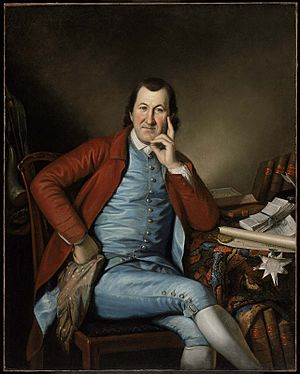Timothy Matlack facts for kids
Quick facts for kids
Timothy Matlack
|
|
|---|---|

Timothy Matlack by Charles Willson Peale, 1790: Museum of Fine Arts, Boston
|
|
| Born | March 28, 1736 |
| Died | April 14, 1829 (aged 93) Holmesburg, Pennsylvania, United States
|
| Resting place | Wetherills Cemetery, Audubon, Pennsylvania |
| Nationality | American |
| Known for | "Scribe of the Declaration of Independence" |
| Spouse(s) |
Eleanor Yarnell
(m. 1758; Elizabeth Claypoole
(m. 1797) |
Timothy Matlack (born March 28, 1736 – died April 14, 1829) was an important leader during the American Revolutionary War. He was known for his excellent handwriting. Because of this skill, he was chosen to write the original United States Declaration of Independence on a special type of parchment called vellum.
Matlack also served as the Secretary of Pennsylvania during the war. In 1780, he was a delegate to the Second Continental Congress. He became a very influential political figure in Pennsylvania.
Contents
Timothy Matlack's Early Life
Timothy Matlack was born in Haddonfield, New Jersey, on March 28, 1736. His parents were Elizabeth Martha Burr Haines and Timothy Matlack. In 1738, his family moved to Philadelphia.
When he was 13, in 1749, he started learning from a successful Quaker merchant named John Reynell. After finishing his training, he married Ellen Yarnall. They had five children together: William, Mordecai, Sibyl, Catharine, and Martha.
In 1760, Matlack opened his own store. He also bought a steel furnace with Owen Biddle in 1762. His shop faced difficulties in 1765. By 1769, he started a new business selling bottled beer and opened his own brewery.
A Key Figure in the Revolution
In 1774, Timothy Matlack was hired to write out an important message to the King of England. This was for the First Continental Congress. In May 1775, he became a clerk for the Second Continental Congress.
In June, he wrote George Washington's official papers to make him General and Commander-in-Chief of the army. Congress then made Matlack the Storekeeper of Military Supplies. He also helped lead Philadelphia's local defense groups.
In January 1776, Matlack was chosen to be a Colonel in the Fifth Battalion of Rifle Rangers. Later that month, he wrote the United States Declaration of Independence on parchment. Members of Congress started signing it on August 2.
Matlack played a big part in creating the Pennsylvania Constitution of 1776. He strongly defended it against people who disagreed with it. He often wrote articles in newspapers using the pen name "Tiberius Gracchus."
As Secretary to the Supreme Executive Council of Pennsylvania, Matlack was one of the most powerful people in the state during the war. In 1780, his government passed a law to slowly end slavery. This was a very important step.
Military Service and Public Roles
Colonel Matlack and his 5th Rifle Battalion joined George Washington in crossing the Delaware River on December 27, 1776. Washington praised the Pennsylvania militia for their help in this important battle.
After the British took over Philadelphia, Washington put Benedict Arnold in charge of the city. Matlack did not like Arnold's actions. He led an investigation into Arnold's behavior. This led to a military trial for Arnold. Arnold's famous act of treason was discovered five months later.
In 1779, Matlack became a trustee for the University of the State of Pennsylvania. In 1780, he joined the American Philosophical Society and served as its Secretary for a few years.
He also helped start The Religious Society of Free Quakers in 1781. These were Quakers who supported the American fight for independence. Matlack was one of the first people in America to speak out against slavery. He helped raise money to build the Free Quaker Meeting House in Philadelphia.
Later Life and Legacy
In 1790, Matlack was asked to explore and map parts of Pennsylvania. This included the "headwaters of the Susquehanna River" and the "New Purchase" area. They also looked for a way to connect the West Branch with the Allegheny River.
From 1799 to 1808, he lived in Lancaster, Pennsylvania, which was the state capital at the time. He worked as a clerk for the Pennsylvania State Senate. He was known for his beautiful garden, which had many types of peach trees.
Timothy Matlack passed away in Holmesburg, Pennsylvania, on April 14, 1829. He was first buried in Philadelphia. Later, in 1905, his remains were moved to Wetherill Cemetery near Valley Forge.
In Popular Culture
- National Treasure (film): In the 2004 movie National Treasure, the character Ben Gates (Nicolas Cage) mentions Timothy Matlack. He explains that Matlack was the official scribe, or writer, for the Continental Congress. Gates says that Matlack wrote the Declaration of Independence.
- American Scribe font: A computer font called American Scribe was created to look like Timothy Matlack's unique handwriting.


